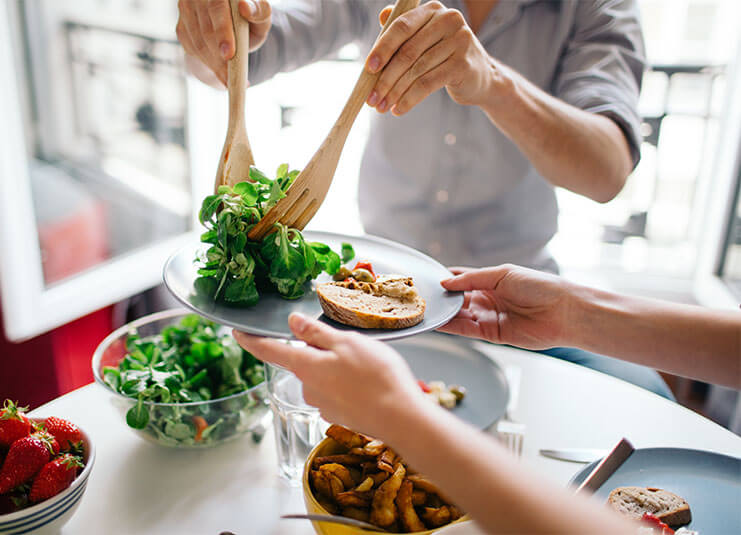Kitchen Prep for Healthy Eating

Once you have made the decision eat healthy, you need to transform your kitchen to ensure you achieve your goals.
A little planning ahead can go a long way toward your success in changing your eating habits. At first, it may seem like a lot of work, but it is worth it! After a while, all of your advance prep will pay off with healthy dividends and saved time. With that in mind, let's get started!
The hard part is looking through your pantry, refrigerator and freezer and deciding what to toss. Start by having an honest conversation with yourself. Admit that it is okay to toss the leftovers and takeout from last week before it turns into something your child may want to use as a science project.
It is easy to find reasons not to get rid of food. Believe me, I have heard them all. A common reason is, "I don't want food to go to waste", even if the extra food will never be eaten or you are hanging onto the stale chips from last year's Superbowl party.
Take a good look at the condiments and bottles of sauces and dressings that you have stocked in your refrigerator and pantry. Get rid of the ones with a high content of sugar and hidden sugar like fructose and syrups. Conduct a clean sweep of processed, additive-laden potions that would keep you from moving forward with your health goals and take them to the garbage can!
When I decided to go organic and to get rid of all processed foods in my house, I started with my pantry and a huge garbage bag. I placed all unopened, still-within-date canned foods, crackers, rice, cookies, bars and pasta and donated these foods to the local food bank.
I subsequently moved to the freezer and took everything out, cleaned it and made a list of existing meat, poultry and fish that I could use up during the transition phase. I looked for recipes that contained these foods and used them quickly.
Once your pantry, refrigerator and freezer are clean, you can start executing your plan.
Step 1: Purchase kitchen tools and containers.
Purchase glass food containers in different sizes and a case of quart size glass canning jars for food storage.
Consider your kitchen tools and make a list of the ones you would like to add to your kitchen:
- Slow cooker or Instant Pot
- Food Processor
- High Speed Blender such as a Blentec or VitaMix
- Juicer
Step 2: Make a list of items to have always on hand in your pantry as quick meals, snacks or part of your meal prep.
- Canned salmon, tuna, sardines, anchovies (BPA free cans)
- Garbanzos, black beans, navy beans, kidney beans, mung beans and cannellini beans (BPA free and organic if you choose to buy canned)
- Lundberg organic Jasmine rice
- Organic quinoa
- Organic buckwheat
- Capers
- Artichoke hearts
- Nut butters
- Nuts
- GF pasta (preferably quinoa or pea based vs rice)
- Coconut butter
- Coconut oil
- Coconut milk
- Coconut water
- Ghee
- Extra Virgin Olive Oil
- Apple Cider Vinegar
- Balsamic Vinegar
- Coconut Aminos
- Dijon Mustard
- Honey
- Stevia
- Organic Maple Syrup
- Pink Himalayan Salt
- Organic Herbs and Spices
Step 3: Choose 10-12 recipes you will rotate as part of your meal plan.
Purchase enough organic, grass-fed or wild-caught meat, fish and poultry to try 3-4 recipes per week. I can help you come up with recipes and will be providing some on a regular basis for our patients. A good source of recipes could also be your local organic grocery store.
Make a list of items to purchase from the above menu. A list of organically fed and raised animal protein includes:
- Bison
- Beef
- Wild Caught Fish
- Turkey
- Chicken
- Eggs
Step 4: Fill your cart with as many organic green vegetables and fruits as your heart desires.
Base your produce purchases on your new meal plan and planned snacks. Once you have your fruits and vegetables:
- Prep leafy greens such as kale, spinach, lettuce and chard as you arrive home from the store. Wash and tear it into bite size pieces and store it in quart size jars, ready to use during the week. Cut broccoli and cauliflower into small pieces and store in your jars for quick use at cooking time.
- Cut carrots and celery for a quick snack. Chop celery and or chop green onions and carrots to have ready to use in soups, stews and other recipes.
- Wash all fruits and root vegetables and store then in the refrigerator, ready for eating as snacks or to be used a part of a meal.
Changing your eating habits is a life altering experience and a great way to make an impact on your health and that of your family. As your eating habits change and you start to see the results, you will be encouraged by your improved lab results, appearance, mood, sleep and well-being. Your nutritionist at NaturoMedica is here to teach, assist and support you every step of the way.


